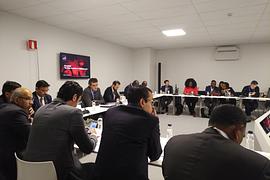



Le 27 février 2019, Grégoire Rota-Graziosi, directeur du Cerdi, Faycal Sawadogo, doctorant du Cerdi et Christophe Angely, directeur de la stratégie de la Ferdi ont participé à une table ronde " The future of taxation in a digitalising world" organisée dans le cadre du programme ministériel du Mobile World Congress.
Grégoire Rota Graziosi a présenté les travaux du Cerdi et de la Ferdi sur la fiscalité numérique. L'objet de ces travaux consiste à évaluer la pression fiscale sur les entreprises de télécommunications dans 9 pays africains. Ce qui a nécessité un recensement détaillé des régimes fiscaux appliqués au secteur des télécommunications dans chacun des pays étudiés. L'objectif est de proposer des scenari de politiques fiscales bénéficiant à la fois aux opérateurs et aux Etats.
The telecommunications sector is one of the most dynamic in Sub-Saharan Africa. Its contribution to the GDP is significant in all countries, for instance 5% in Niger, 4.9% in DRC[1] and 6.4% in Guinea[2]. However, a significant margin of progression exists in many SSA countries, since the mobile network penetration rate (percentage of the population with access to the network) was only 43% in Niger and 44% in DRC in 2017 when the African average barely exceeded 67% (GSMA).
In spite of economic integration, the telecommunications market remains fragmented with national legislations and regulations. Direct taxation, indirect taxes (ad valorem or specific excise duties), and parafiscal levies alongside with the licensing fees, have an unquestionable negative effect on the development of the sector.
FERDI developed an Average Effective Tax Rate (AETR) model based on the life length of a mobile telecommunications license. This approach captures more consistently the tax pressure as compared with the usual metric, e.g., the ratio of tax to to revenues. Indeed, the AETR takes into account the multiple stages of mobile phone license exploitation, the cost of capital, the current and past tax regimes (including customs and parafiscal levies). At the request of Orange, FERDI applied this approach to Orange’s subsidiaries in nine African countries. Given the sensitivity of financial data and disclosure rules, the GSMA presentation is based on the average data of a representative mobile phone company operating in three African countries: Cameroon, Guinea, and Niger.
The computed AETR for the representative mobile phone company is high. In each studied countries, its level is significantly higher than what is observed in other industries, especially in the extractive sector such as gold mining.[3]
Beyond actual tax pressure, the AETR approach allows an analysis of the impact of alternative tax systems and tax reforms, in particular: the removal of specific taxation on the mobile telecommunications sector except for license fees and the implementation of a stability clause, which freezes tax system at the date of obtaining the license. To deal with tax incidence and demand elasticity issues, FERDI developed a counterfactual approach based on the S-shape curve of innovation adoption simulating potential market penetration and turnover.
In all the countries we present here (and almost all the countries we studied for Orange), the alternative schemes essentially improve tax revenue and operators’ profit through a less distorting tax regime. They reinforce the Treasury Single Account by increasing standard tax revenue, mainly Corporate Income Tax and Value Added Tax.
This approach provides a ground for discussing tax policy applied to telecommunications firms, taking into account detailed investments and operating costs over the licensing period.
[1] According to the World bank
[2] According to GSMA
[3] The methodology that we adopt follows the Fiscal Analysis of Resources Industries (FARI) developed by the International Monetary Fund (see https://www.imf.org/external/np/fad/fari/). However, our methodology differs from the IMF approach in several points. For instance, while a national royalty rate has no incidence on the commodity price at the worldwide level, any specific tax on telecommunication affects the price of provided services, firms’ turnover, and market penetration. We then have to build counterfactual turnover that is the turnover, which would have been observed without this specific taxation.